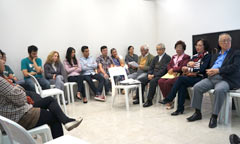Discussion about Okinawa under U.S. military occupation held at Brazil

On June 24, at the Brazil Okinawa Cultural Center in Sao Paulo, Brazil, a discussion was held with first-generation Okinawan Brazilians as guests.
July 4, 2012 Akiko Yasuhara Correspondent of Ryukyu Shimpo
On June 24, at the Brazil Okinawa Cultural Center in Sao Paulo, a discussion involving first-generation Okinawan Brazilians was held to mark the 40th anniversary of the reversion of Okinawa to Japanese sovereignty and to deepen the understanding of Okinawa, which was under the U.S. military occupation. According to the Brazil Okinawa Kenjin-Kai, this is the first event held in Brazil to commemorate the 40th anniversary of Okinawa reversion.
One of the organizers of the discussion, Satomi Matsumoto, who is a student and third-generation Okinawan Brazilian, explained that when she first visited Okinawa four years ago she was shocked at the serious nature of the U.S. military bases issue. She said that the popular image of Okinawa in Brazil is of its culture and beautiful sea, saying, “Many young Okinawan Brazilians don’t know the history of Okinawa under U.S. occupation or anything about the base issues. I wanted to create an opportunity to share information about these things.”
In the discussion, five first-generation Okinawan Brazilians who moved to Brazil during the postwar years explained aspects of Okinawa under U.S. military occupation. Alice Tarama, who was ten years old when the war ended, spoke of how she accepted food from U.S. military in order to survive, saying, “I want young people to understand the history of Okinawa and the misery of war.”
In addition to the discussion, a photo exhibition of Okinawa before the reversion was held and there were approximately 50 visitors. Keiko Nakamatsu, who is third-generation Okinawan Brazilian, said, “I knew something about the base issue in Okinawa, but now I would like to know more about it.”
(English translation by T&CT, Lima Tokumori and Mark Ealey)
Previous Article:Cargo ship carrying Osprey aircraft departs U.S. port for Iwakuni
Next Article:Crabs spawn in Ikema-jima
[Similar Articles]
- Brazil Okinawa Kenjin-Kai celebrates 85th anniversary by honoring forerunners’ efforts
- Monument for the 100th year of Okinawan immigration to Brazil unveiled
- Japan Times reporter writes about the current state of affairs for the Okinawan dialect
- “We hope to let people know about the Okinawa reversion movement,” ― Hentona High School Students make a film
- Celebrating 110 years of Okinawa to Brazil immigration
 Webcam(Kokusai Street)
Webcam(Kokusai Street)


